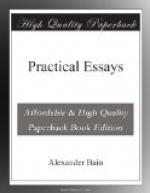[LOGIC IN THE MIDDLE AGES.]
THE MIDDLE AGE AND BOETHIUS.
I must skip eight centuries, to introduce the man that linked the ancient and the modern world, and was almost the sole luminary in the west during the dark ages, namely, Boethius, minister of the Gothic Emperor Theodoric. As much of Aristotle as was known between the 6th and the 11th centuries was handed down by him. During that time, only the logical treatises existed among the Latins; and of these the best parts were neglected. Historical importance attaches to a small circle of them known as the Old Logic (vectus logica), which were the pabulum of abstract thought for five dreary centuries. These consisted of the two treatises or chapters of Aristotle called the “Categories,” and the “De Interpretatione,” or the Theory of Propositions; and of a book of Porphyry the Neo-Platonist, entitled ‘Introduction’ (Isagoge), and treating of the so-called Five Predicables. A hundred average pages would include them all; and three weeks would suffice to master them.
Boethius, however, did much more than hand on these works to the mediaeval students; he translated the whole of Aristotle’s logical writings (the Organon), but the others were seldom taken up. It was he too that handled the question of Universals in his first Dialogue on Porphyry, and sowed the seed that was not to germinate till four centuries afterwards, but which, when the time came, was to bear fruit in no measured amount. And Boethius is the name associated with the scheme of higher education that preceded the University teaching, called the quadrivium, or quadruple group of subjects, namely, Arithmetic, Geometry, Music and Astronomy. This, together with the trivium, or preparatory group of three subjects—Grammar, Rhetoric, and Logic—constituted what was known as the seven liberal arts; but, in the darkest ages, the quadrivium was almost lost sight of, and few went beyond the trivium.
EVE OF THE UNIVERSITY.
In the 7th century, the era of deepest intellectual gloom, philosophy was at an entire stand-still. Light arises with the 8th, when we are introduced to the Cathedral and Cloister Schools of Charlemagne; and the 9th saw these schools fully established, and an educational reform completed that was to be productive of lasting good results. But the range of instruction was still narrow, scarcely proceeding beyond the Old Logic, and the teachers were, as formerly, the Monks. The 11th century is really the period of dawn. The East was now opened up through the Crusades, and there was frequent intercourse with the learned Saracens of Spain; and thus there were brought into the West the whole of Aristotle’s works, with Arabic commentaries, chiefly in Latin translations. The effervescence was prodigious and alarming. The schools were reinforced by a higher class of teachers, Lay as well as Clerical; a marked advance was made in Logic and Dialectic; and the great controversy of Realism versus Nominalism, which had found its birth in the previous century, raged with extraordinary vigour. We are now on the eve of the founding of the Universities; Bologna, indeed, being already in existence.




